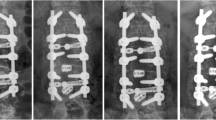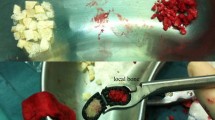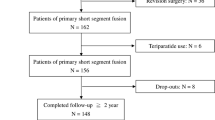Abstract
Objective
To evaluate whether a synthetic bone chip made of porous hydroxyapatite can effectively extend local decompressed bone graft in instrumented posterior lumbar interbody fusion (PLIF).
Methods
130 patients, 165 segments, who had undergone PLIF with cages and instrumentation for single or double level due to degenerative conditions, were investigated retrospectively by independent blinded observer. According to the material of graft, patients were divided into three groups. HA group (19 patients, 25 segments): with hydroxyapatite bone chip in addition to autologous local decompressed bone, IBG group (25 patients, 28 segments): with autologous iliac crest bone graft in addition to local decompressed bone and LB group (86 patients, 112 segments): with local decompressed bone only. Radiologic and clinical outcome were compared among groups and postoperative complications, transfusion, time and cost of operation and duration of hospitalization were also investigated.
Results
Radiologic fusion rate and clinical outcome were not different. Economic cost, transfusion and hospital stay were also similar. But operation time was significantly longer in IBG group than in other groups. There were no lasting complications associated with HA and LB group with contrast to five cases with persisting donor site pain in IBG group.
Conclusion
Porous hydroxyapatite bone chip is a useful bone graft extender in PLIF when used in conjunction with local decompressed bone.

Similar content being viewed by others
References
Turner JA, Ersek M, Herron L, Haselkorn J, Kent D, Ciol MA, Deyo R (1992) Patient outcomes after lumbar spinal fusions. JAMA 268:907–911
Jaslow IA (1946) Intercorporal bone graft in spinal fusion after disc removal. Surg Gynecol Obstet 82:215–218
Cloward RB (1953) The treatment of ruptured lumbar intervertebral discs by vertebral body fusion. I. Indications, operative technique, after care. J Neurosurg 10:154–168. doi:10.3171/jns.1953.10.2.0154
Brantigan JW, Steffee AD (1993) A carbon-fiber implant to aid interbody lumbar fusion—2-year clinical-results in the 1st 26 patients. Spine 18:2106–2117
Brantigan JW, Steffee AD, Geiger JM (1991) A carbon-fiber implant to aid interbody lumbar fusion—mechanical testing. Spine 16:S277–S282
Brantigan JW, Steffee AD, Lewis ML, Quinn LM, Persenaire JM (2000) Lumbar interbody fusion using the Brantigan I/F cage for posterior lumbar interbody fusion and the variable pedicle screw placement system: two-year results from a Food and Drug Administration investigational device exemption clinical trial. Spine (Phila Pa 1976) 25:1437–1446
Boden SD (2002) Overview of the biology of lumbar spine fusion and principles for selecting a bone graft substitute. Spine (Phila Pa 1976) 27:S26–S31
Whang PG, Wang JC (2003) Bone graft substitutes for spinal fusion. Spine J 3:155–165 (S1529943002005399)
Kessler P, Thorwarth M, Bloch-Birkholz A, Nkenke E, Neukam FW (2005) Harvesting of bone from the iliac crest—comparison of the anterior and posterior sites. Br J Oral Maxillofac Surg 43:51–56. doi:10.1016/j.bjoms.2004.08.026
Kim DH, Rhim R, Li L, Martha J, Swaim BH, Banco RJ, Jenis LG, Tromanhauser SG (2009) Prospective study of iliac crest bone graft harvest site pain and morbidity. Spine J 9:886–892. doi:10.1016/j.spinee.2009.05.006
Ito Z, Matsuyama Y, Sakai Y, Imagama S, Wakao N, Ando K, Hirano K, Tauchi R, Muramoto A, Matsui H, Matsumoto T, Kanemura T, Yoshida G, Ishikawa Y, Ishiguro N (2010) Bone union rate with autologous iliac bone versus local bone graft in posterior lumbar interbody fusion. Spine (Phila Pa 1976) 35:E1101–E1105. doi:10.1097/BRS.0b013e3181de4f2e
Ohtori S, Suzuki M, Koshi T, Takaso M, Yamashita M, Yamauchi K, Inoue G, Orita S, Eguchi Y, Ochiai N, Kishida S, Kuniyoshi K, Nakamura J, Aoki Y, Ishikawa T, Arai G, Miyagi M, Kamoda H, Toyone T, Takahashi K (2010) Single-level instrumented posterolateral fusion of the lumbar spine with a local bone graft versus an iliac crest bone graft: a prospective, randomized study with a 2-year follow-up. Eur Spine J. doi:10.1007/s00586-010-1656-7
Thalgott JS, Giuffre JM, Fritts K, Timlin M, Klezl Z (2001) Instrumented posterolateral lumbar fusion using coralline hydroxyapatite with or without demineralized bone matrix, as an adjunct to autologous bone. Spine J 1:131–137 (S1529-9430(01)00011-0)
Kraiwattanapong C, Boden SD, Louis-Ugbo J, Attallah E, Barnes B, Hutton WC (2005) Comparison of Healos/bone marrow to INFUSE(rhBMP-2/ACS) with a collagen-ceramic sponge bulking agent as graft substitutes for lumbar spine fusion. Spine (Phila Pa 1976) 30:1001–1007; discussion 1007 (00007632-200505010-00003)
Neen D, Noyes D, Shaw M, Gwilym S, Fairlie N, Birch N (2006) Healos and bone marrow aspirate used for lumbar spine fusion: a case controlled study comparing healos with autograft. Spine (Phila Pa 1976) 31:E636–E640. doi:10.1097/01.brs.0000232028.97590.12
Carter JD, Swearingen AB, Chaput CD, Rahm MD (2009) Clinical and radiographic assessment of transforaminal lumbar interbody fusion using HEALOS collagen-hydroxyapatite sponge with autologous bone marrow aspirate. Spine J 9:434–438. doi:10.1016/j.spinee.2008.11.004
Hashimoto T, Shigenobu K, Kanayama M, Harada M, Oha F, Ohkoshi Y, Tada H, Yamamoto K, Yamane S (2002) Clinical results of single-level posterior lumbar interbody fusion using the Brantigan I/F carbon cage filled with a mixture of local morselized bone and bioactive ceramic granules. Spine (Phila Pa 1976) 27:258–262
Brantigan JW, Steffee AD (1993) A carbon fiber implant to aid interbody lumbar fusion. Two-year clinical results in the first 26 patients. Spine (Phila Pa 1976) 18:2106–2107
Association JO (1986) Assessment of treatment of low back pain. J Jpn Orthop Assoc 60:391–394
Lee JH, Hwang CJ, Song BW, Koo KH, Chang BS, Lee CK (2009) A prospective consecutive study of instrumented posterolateral lumbar fusion using synthetic hydroxyapatite (Bongros-HA) as a bone graft extender. J Biomed Mater Res A 90:804–810. doi:10.1002/jbm.a.32113
van Loon CJ, de Waal Malefijt MC, Buma P, Stolk T, Verdonschot N, Tromp AM, Huiskes R, Barneveld A (2000) Autologous morsellised bone grafting restores uncontained femoral bone defects in knee arthroplasty. An in vivo study in horses. J Bone Joint Surg Br 82:436–444
Lee C, Dorcil J, Radomisli TE (2004) Nonunion of the spine: a review. Clin Orthop Relat Res 2004:71–75 (00003086-200402000-00012)
Lee JH, Jeon DW, Lee SJ, Chang BS, Lee CK (2010) Fusion rates and subsidence of morselized local bone grafted in titanium cages in posterior lumbar interbody fusion using quantitative three-dimensional computed tomography scans. Spine (Phila Pa 1976) 35:1460–1465. doi:10.1097/BRS.0b013e3181c4baf5
Ylinen P, Kinnunen J, Laasonen EM, Lamminen A, Vainionpaa S, Raekallio M, Rokkanen P, Tormala P (1991) Lumbar spine interbody fusion with reinforced hydroxyapatite implants. Arch Orthop Trauma Surg 110:250–256
Ripamonti U, Ma SS, van den Heever B, Reddi AH (1992) Osteogenin, a bone morphogenetic protein, adsorbed on porous hydroxyapatite substrata, induces rapid bone differentiation in calvarial defects of adult primates. Plast Reconstr Surg 90:382–393
Bilgic S, Sahin B, Sonmez OF, Odaci E, Colakoglu S, Kaplan S, Ergur H (2005) A new approach for the estimation of intervertebral disc volume using the Cavalieri principle and computed tomography images. Clin Neurol Neurosurg 107:282–288. doi:10.1016/j.clineuro.2004.08.001
Acknowledgments
This work was supported by Research Settlement Fund for the new faculty of Seoul National University.
Conflict of interest
None.
Author information
Authors and Affiliations
Corresponding author
Rights and permissions
About this article
Cite this article
Kim, H., Lee, CK., Yeom, JS. et al. The efficacy of porous hydroxyapatite bone chip as an extender of local bone graft in posterior lumbar interbody fusion. Eur Spine J 21, 1324–1330 (2012). https://doi.org/10.1007/s00586-011-2092-z
Received:
Revised:
Accepted:
Published:
Issue Date:
DOI: https://doi.org/10.1007/s00586-011-2092-z




